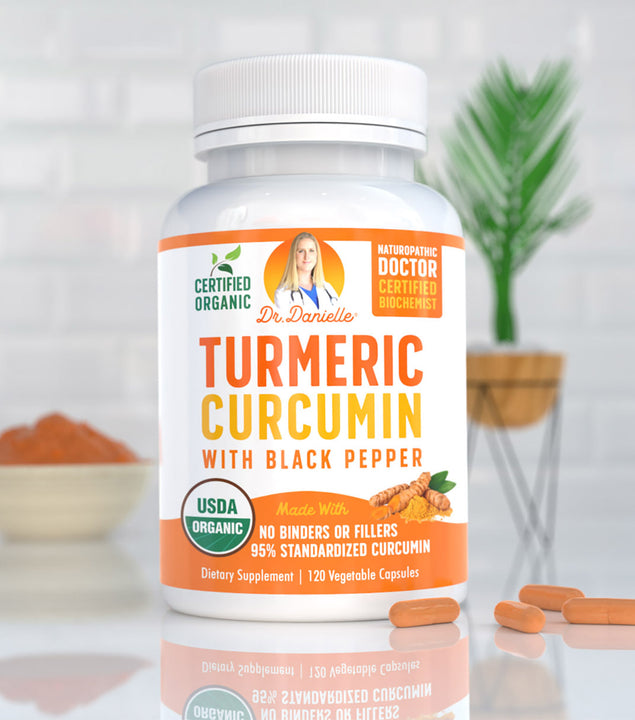The Christmas festivities are behind us. As you finish that mountainous heap of leftovers—ham for breakfast, lunch, and dinner—you’re undoubtedly feeling a little … well, sick of all the overindulgence. While you may be tempted to hop on a “cleansing detox diet plan” the minute you’re down to your last slice of ham (or your choice of holiday protein staple) to start 2023 on a healthier note, here’s a piece of advice: don’t.
No detox diet can “flush the body of toxins” or “improve overall health” (1, 2). Worse still, most deprive your body of crucial nutrients, leading to side effects like low blood sugar, fatigue, and brain fog. Not a good way to step into 2023 at all.
So, what then? How can you eat healthier in the new year ahead without going on a cleanse? Or any other unsustainable fad diet? In truth, healthy eating doesn’t need to be confusing or complicated. With adequate basic nutritional knowledge, you’ll eat healthier in no time—even if you don’t have the luxury of time to meal prep.
#1: Understanding the big picture (calories and macronutrients)
For the uninitiated, a calorie is a unit of measurement for the energy value of food (3). For example, 100 grams of:
- Chicken breast: 165 calories (4)
- Steak: 271 calories (5)
- Mars Snickers Crunchers bars: 488 calories (6)
- Apples: 52 calories (7)
The calorie count of a food describes how much energy your body can get from eating or drinking it. Despite their reputation, calories aren't bad for you per se; they fuel your body's activities (e.g., breathing, digestion, and physical activities). But eating too many—more than your body burns—can lead to excessive weight gain, putting you at risk of health problems (8, 9, 10). So, should you eat very little, then? Definitely not.
Why look at macronutrients?
Instead of universally cutting down on your food intake, pay attention to each food item’s macronutrient composition to determine which you should limit (emphasis: this doesn't say 'eliminate'). Macronutrients are types of foods that are needed in large quantities in the diet, and they include (11):
- Carbohydrates: Sugars, starches, and fibers found in fruits, grains, vegetables, and milk products. You can find them in bread, pasta, corn, potatoes, cookies, and apple pie. Every gram of carbohydrate provides four calories. Note: dietary fibers typically contain fewer than four calories (we're talking one to two) per gram (12).
- Proteins: Made up of long chains of amino acids. Both animal (e.g., seafood, poultry, and eggs) and plant foods (e.g., legumes, nuts, seeds, and soy products) can be excellent protein sources. Every gram of protein provides four calories.
- Fats: There are three “types” of fat, listed in order of healthiest to least: unsaturated (predominantly found in foods from plants, like vegetable oils, nuts, and seeds), saturated (mainly found in animal foods), and trans fats (e.g., partially hydrogenated oil, beef fat, and dairy fat). Every gram of fat provides nine calories.
Going back to our food examples and their respective calorie counts, you should now see why 100 grams of steak contains more calories than chicken breast. The former contains less protein (four calories per gram) and more fat (nine calories per gram) than the latter. While everyone’s nutritional needs are unique, in general, a recommended macronutrient distribution range—in terms of percentage energy contribution to diet—is as follows (13):
- Carbohydrates: 45% to 75%
- Proteins: 10% to 35%
- Fats: 15% to 35%
#2: Zooming in on the specifics (micronutrients and others)
A hundred grams of Mars Snickers Crunchers bars contains a whopping 488 calories. That's nearly ten times more calories you'd get if you ate 100 grams of apples. So, in that sense, Mars bars are more "energy dense" than apples. Since satiety is typically associated with food volume (i.e., the more volume you eat, the more full you'll feel), you should ideally limit your consumption of energy-dense foods to better manage your calorie intake (14).
Does that mean all energy-dense foods are bad while all “energy-light” foods are good? Not necessarily. We must also look at a food’s nutrient density. The nutrient density of a food is the ratio of beneficial ingredients, like vitamins and minerals, to its energy content (15, 16, 17, 18). Once again, let's look at Mars bars. Do they contain any health-beneficial nutrients beyond the three macronutrients? No. All they provide are "empty calories".
Compare that to the most energy-dense fruit, the avocado, which provides 160 calories per 100 grams (19). Because it’s an excellent source of magnesium, potassium, vitamin C, vitamin E, and vitamin K, it’s a nutrient-dense food that’s “healthier” than a Mars bar (even when the calories are equated).
A quick way to tell if a food is nutrient dense
But how can you distinguish between foods that offer nothing much but empty calories (i.e., bad for you) and those that are nutrient-dense (i.e., good for you)? Here’s a shortcut: look at its degree of processing (20, 21):
- Unprocessed or minimally processed foods: Unprocessed foods include the natural edible parts of plants and animals. On the other hand, minimally processed foods have been slightly altered—read: no substantial change in nutritional content—for the primary purpose of preservation. Examples include fresh fruits, vegetables, whole grains, nuts, meats, and milk.
- Processed foods: Foods that have added salt, sugar, or fats. They're usually ready to eat. Examples include canned fruits and vegetables, cheeses, freshly made bread, and canned fish.
- Ultra-processed foods: These are foods that go beyond incorporating salt, sweeteners, or fat. Instead, they're jam-packed with artificial colors, flavors, and preservatives that promote shelf stability, preserve texture and increase palatability. In addition, most are low in fiber and nutrients. Examples include cookies, some crackers, breakfast cereals, and luncheon meats.
In general, a less-processed food will contain more nutrients and less of the following health-harming ingredients (when consumed in excess):
- Added sugar: Research links excessive added sugar consumption with higher blood pressure, inflammation, weight gain, diabetes, fatty liver disease, and an increased risk for heart attack and stroke (22, 23, 24, 25).
- Saturated fat and hydrogenated oils: Both types of fat can raise your low-density lipoprotein (LDL) cholesterol levels. LDL is also known as "bad cholesterol" (26, 27, 28). And unfortunately, higher cholesterol levels could increase your risk of developing heart disease (29).
- Sodium: Research suggests that salt-rich diets could raise blood pressure (which results in a higher risk of heart disease and stroke) and increase stomach cancer risk (30, 31, 32).
#3: Healthy eating tips for all occasions

Okay, so how can you apply all this newfound knowledge to your daily life stepping into the new year? Here are a few tips for when you’re:
- Grocery shopping: If you're preparing your own meals, choose unprocessed or minimally processed ingredients (e.g., go for chicken breast instead of chicken sausages). Limit the amount of ultra-processed snacks, like potato chips, brownies, and ice cream, that you purchase, too. And if you’re deciding between frozen meals, look at their nutritional information before making your choice. How many calories will you be eating? What about trans-fats? (So on and so forth.)
- Eating out with friends, family, or colleagues: Avoid ordering deep-fried dishes (e.g., fish and chips). These are bursting with fat—and, thus, calories. Instead, go for a more nutritionally balanced meal with a good mix of complex carbohydrates, lean proteins, and healthy fats. Examples include grilled chicken paired with stir-fried broccoli and rice, plus the vegan-friendly sweet potato and cauliflower lentil bowl.
- Celebrating a special occasion or on holiday: Healthy eating isn't about elimination, restriction, or pure misery. Instead, it comes down to moderation. So, no, you don't have to opt for bland-tasting salads or sauce-less poke bowls when you're celebrating special occasions (e.g., a promotion, an anniversary, or a birthday) or on holiday. You can eat deep-fried dishes. You can indulge in that ultra-processed, nutrient-poor slice of cake. Just not too often—and not for every meal. Note: in general, this applies to daily life, too.
Tiny diet tweaks can lead to major health-boosting results

Think of “healthy eating”, and most people will think of tiny, miserable-looking salads or cartons of juice cleanses. But, as outlined in this article, you don’t need to make drastic overnight changes in your diet to practice healthier eating. Ultimately, it comes down to this: eat more nutrient-dense, minimally processed foods while limiting your consumption of energy-dense, ultra-processed foods. You don't have to count calories or micromanage your macronutrients. For example, simply opting for grilled fish over fried fish at the restaurant is a step toward healthier eating (yes, it can be as simple as that!)
Of course, if you’re concerned you may be getting too little of certain dietary nutrients, you could always consider using supplements to close the gap. Micronutrients worth your attention include:
- Vitamin C (found in Dr. Danielle’s Elderberry Immune Assist): A powerful antioxidant that may help protect against immune system deficiencies, cardiovascular disease, and prenatal health problems (33).
- Vitamin D (found in Dr. Danielle’s Vitamin D3 + B12 Gummies): Helps regulate the amount of calcium and phosphate—nutrients needed to keep bones, teeth, and muscles healthy—in the body (34). It may also play an essential role in mood regulation.
- Vitamin B12 (found in Dr. Danielle’s Vitamin B12): Needed to form oxygen-carrying red blood cells and DNA (35). Also a key player in the function and development of brain and nerve cells.








